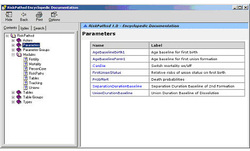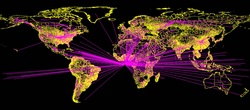MicroSimulation
http://en.wikipedia.org/wiki/Microsimulation
|
ModGen
Modgen (Model generator) is a generic microsimulation programming language supporting the creation, maintenance and documentation of dynamic microsimulation models. Several types of models can be accommodated, be they continuous or discrete time, with interacting or non-interacting populations. ModGen: ModGen 10 Software:
ModGen Models: LifePath LifePaths is a dynamic longitudinal microsimulation model of individuals and families. Using behavioural equations estimated using a variety of historical micro-data sources, LifePaths creates statistically representative samples consisting of complete lifetimes of individuals. The model’s behavioural equations generate, at sub-annual resolution, the discrete events that together constitute an individual’s life history. In addition to its longitudinal capabilities, a complete set of overlapping cohorts allow LifePaths to produce accurate and representative cross-sectional results from the year 1971 onwards. An inventory of Canadian microsimulation models (2011) JAMSIM: a Microsimulation Modelling Policy Tool MicroSimulation OpenM++ (Open Source Microsimulation) |
IBM SpatioTemporal Epidemiological Modeler (STEM)
The Spatiotemporal Epidemiological Modeler (STEM) tool is designed to help scientists and public health officials create and use spatial and temporal models of emerging infectious diseases. These models can aid in understanding and potentially preventing the spread of such diseases. http://researcher.watson.ibm.com/researcher/view_group.php?id=883 http://www.eclipse.org/stem/ Cancer Intervention and Surveillance Modeling Network (CISNET)
CISNET is a consortium of NCI-sponsored investigators that use statistical modeling to improve our understanding of cancer control interventions in prevention, screening, and treatment and their effects on population trends in incidence and mortality. These models can be used to guide public health research and priorities. http://cisnet.cancer.gov/ Journal of Artificial Societies and Social Simulation
http://jasss.soc.surrey.ac.uk/JASSS.html Simulation Technology for Applied Research |


